
Jump to: Ideal Growing Conditions for Guava, Where to Plant Guava in Your Dome, Planting Guava, Guava Companion Plants, Caring for Guava, How to Manage Pests, When to Harvest Guava
Growing Guava Quick Facts:
Genus Name: Psidium guajava
Common Name: Guava
Type: Tree, Fruit
USDA Zone: 9-11
Climate: Tropical/Sub-tropical
Sunlight: Full Sun
Height: Up to 20 feet
Width: Up to 15
Soil: Well-drained, pH 5 to 7
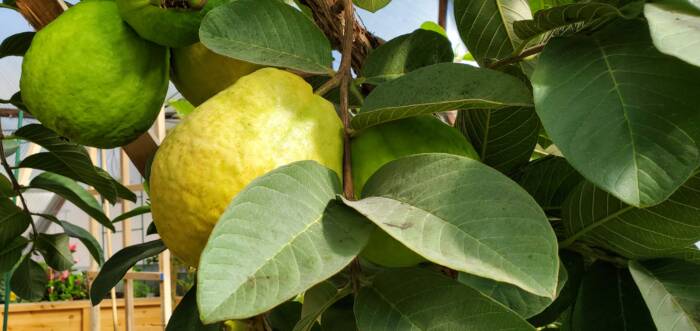
Guava is a short, wide evergreen shrub native to Central and South America. It is a member of the Myrtle family and closely related to the rose apple.
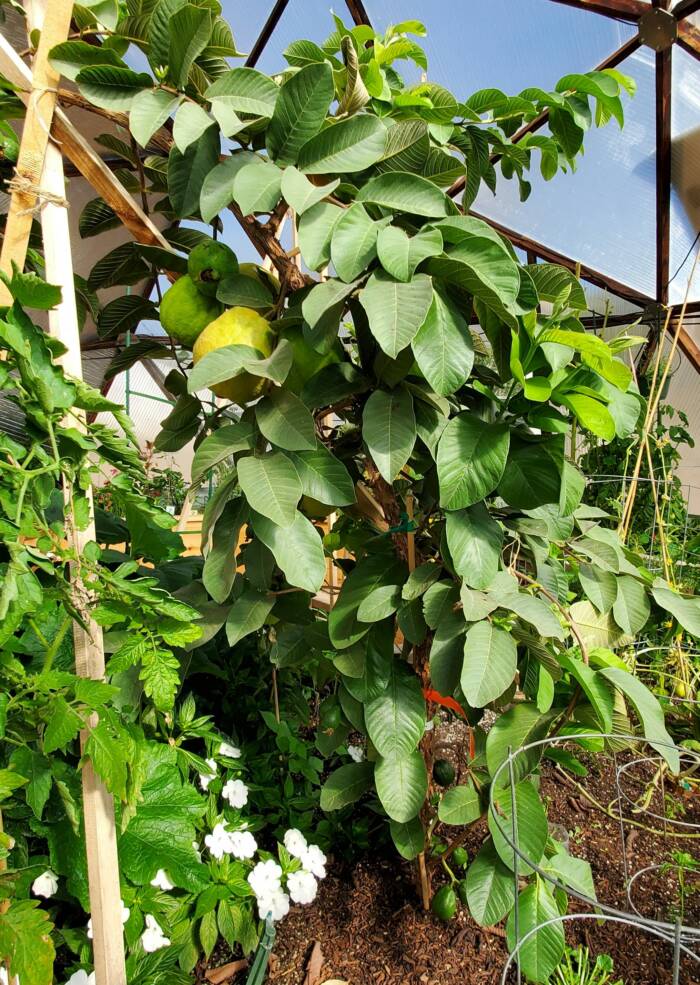
Growing Guava
Guava trees are found in tropical and subtropical regions where there is a hot and humid climate. They do not tolerate frost at all, however, if you live in a cooler climate you can grow guava in a greenhouse or in your home!
If you live in a cool/cold climate and you are growing guava in a greenhouse, it will have to be heated in the winter. If you do not want to use heat you can move your guava indoors for the winter…it’s like a snowbird!
Guava trees can take up to 8 years to produce fruit if planted from seed and there is no guarantee they will come true from seed. The quicker option is to either buy one as a tree or graft one onto established root stock as many commercial nurseries do.
Ideal Growing Conditions for Guava
Guava prefers full sun and grows best in USDA Zones 9-11. You can keep your guava tree happy in your greenhouse by providing a warm, humid climate. You might consider installing a simple misting system for your guava to give it the humidity required, but too much humidity can cause rust fungus on the leaves. If you live in an environment with a warm spring or summer, guava can be moved outside in the sunshine, but keep in mind that they are very sensitive to the slightest bit of frost.
According to a Dome Owner in our Facebook Group, “You can plan for your temps to emulate 2-3 zones up from your standard zone”. For more information on the microclimates in your dome, visit our website.
Where to Plant Guava in Your Dome
Guava is a tropical plant so whether you plant it in a bed or grow it in a pot it will need to be in the warmest area of your dome. Typically that is the center bed and close to the above ground pond, which also acts as your thermal mass, providing heat in the winter. Guava also needs a minimum of 6 hours of sunlight per day, but 8-10 hours is ideal. Being in full sun will help your tree produce more flowers which will mean more fruit!
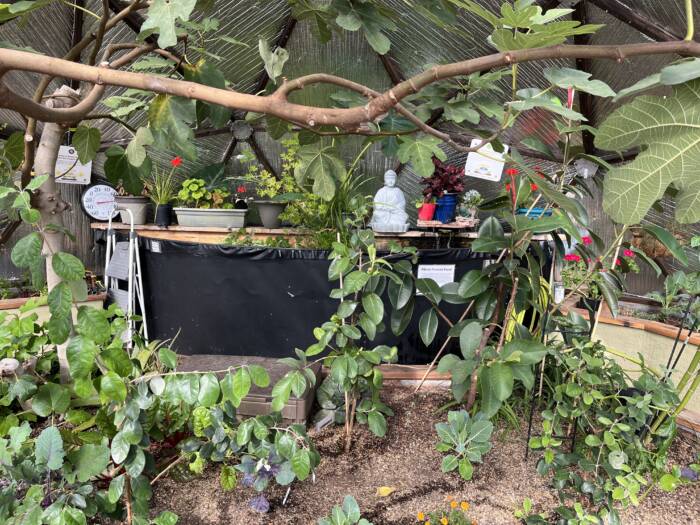
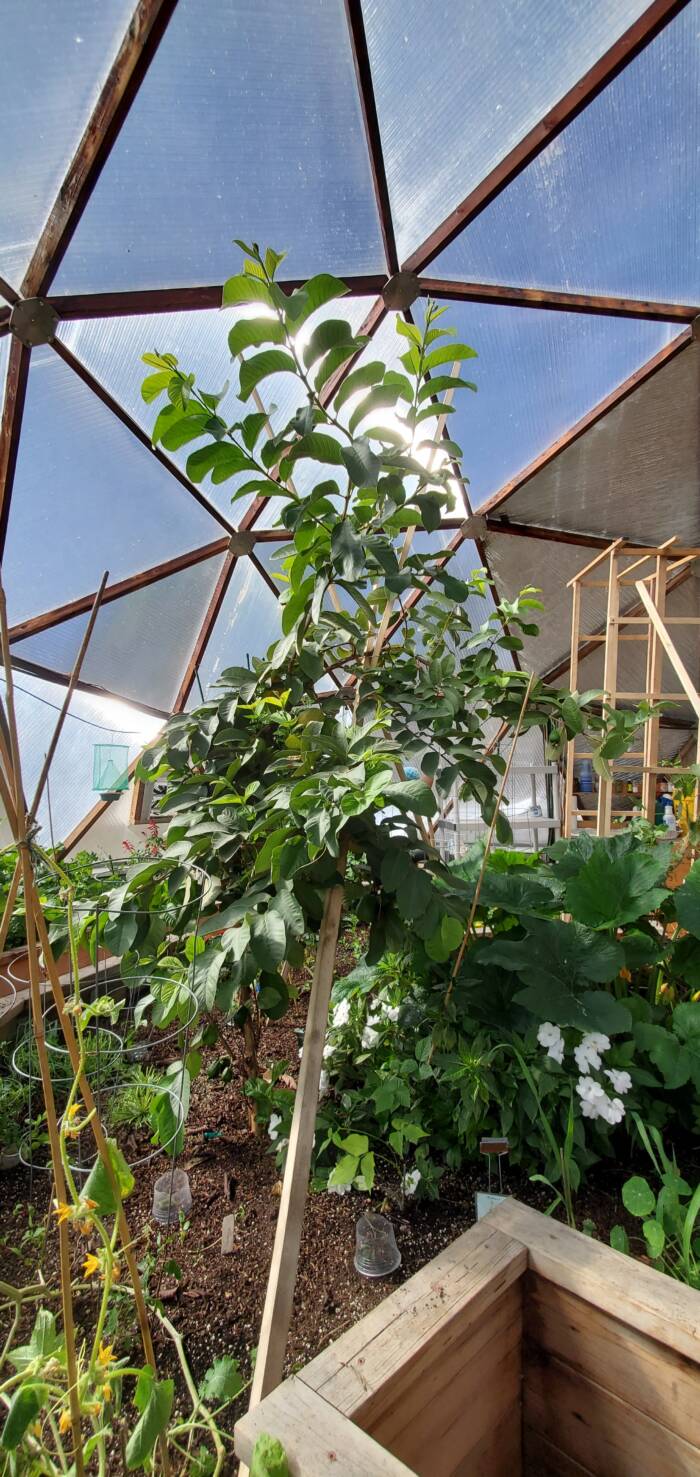
Planting Guava
Planting guava will depend on one major decision: will you heat your growing dome or not? If you will not be heating your dome greenhouse then plant your guava in a pot. If you plan on heating your dome then the guava will be happy directly in a raised bed. To plant a guava tree the soil must be at least 45 degrees, but it is better to plant after the soil temperature has reached 50 degrees. Plant your guava in a raised bed in your growing dome where it will get the most sun with a minimum of 6 hours of sun per day; 8-10 hours is better.
If you will be moving your guava into your home in the winter, plant the young guava in a pot that is at least 15” in diameter. (It’s best to re-pot your guava tree into a bigger pot each spring.) The pot or planter must be large enough to accommodate the root ball. Guava trees prefer soil with a lot of organic matter, a pH of 5-7 and good drainage. Water newly planted trees every other day for about a week and once or twice per week during the growing season.
Another important factor is: seed or plant? If you plant guava seeds be aware that the tree does not always come true from seed AND it will be years before your tree will produce fruit, if at all. Commercial growers propagate guava plants via air layering or grafting.
Growing Guava Companion Plants
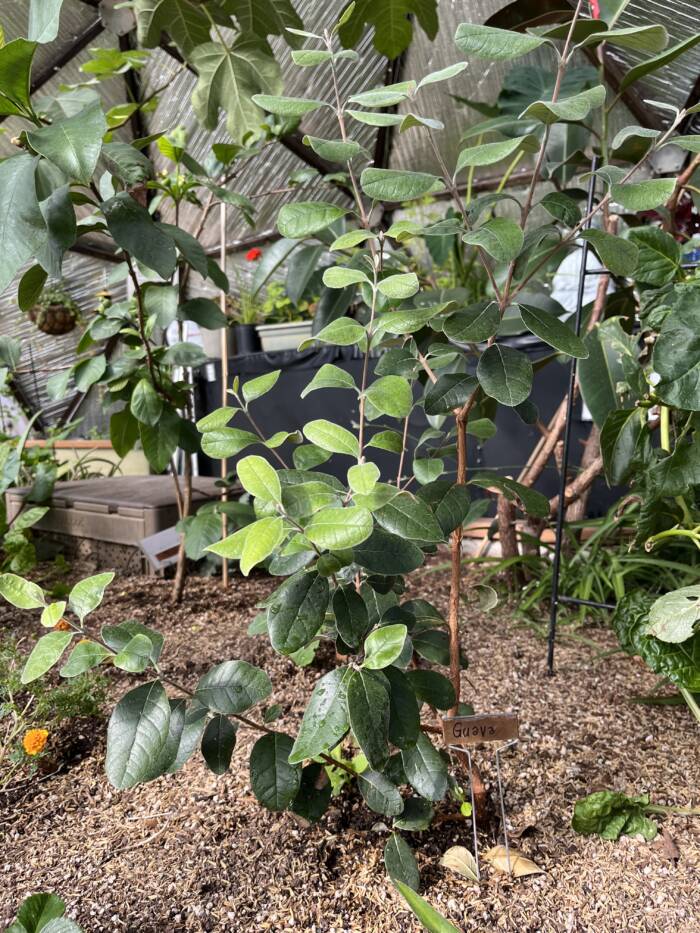
Guava trees are self-pollinating, but having flowers around is helpful to attract beneficial insects to your tree. Some good neighbors to have around your guava are borage, marigolds, chives, comfrey and other citrus trees. Avoid planting root vegetables near guava trees as they will interfere with the tree’s roots.
Caring for Guava
Water young guava trees every other day until they become established and are somewhat drought tolerant. However, it is important to keep guava trees fairly moist during the blooming and fruiting season. Care for your guava tree as you would any fruit tree after the tree is established. Make sure your guava has good drainage as it doesn’t like its roots wet.
Guava needs a bit of fertilizer throughout the growing season, but it’s best not to fertilize in the winter. It’s important to provide your guava tree with a high amount of the following: nitrogen, phosphoric acid, plus potash and magnesium for fruit production. A good formula to work into the soil in early spring is 6-6-6-2 three times during the growing season.
How to Manage Guava Pests
Guava trees are attractive to aphids, scale and caterpillars so keep a close eye on your tree. Looking under the leaves should be standard practice for plants in your greenhouse as the dome is a happy environment for your plants and pests, especially when the temperatures outside are cold. Scale, aphids, and other soft body insects can be easily treated with rubbing alcohol on a cloth and a light scrub. Neem oil and insecticidal soap can help with infestations. Harvesting fruit when ready is also important. Leaving fruit to become overly ripe is very attractive to pests and not healthy for your tree.


Can Guava Trees Thrive Year-Round?
As a tropical plant, guava requires a tropical environment. If you are willing to create a tropical oasis in your home or greenhouse, your guava will be happy. Guava is like your snowbird relative that heads south for the winter, but comes back when it gets too hot. If you can accommodate a guava tree’s needs in your home or greenhouse, your guava will be happy. A hint of frost or too much heat will upset your lovely plant.
When and How to Harvest Guava
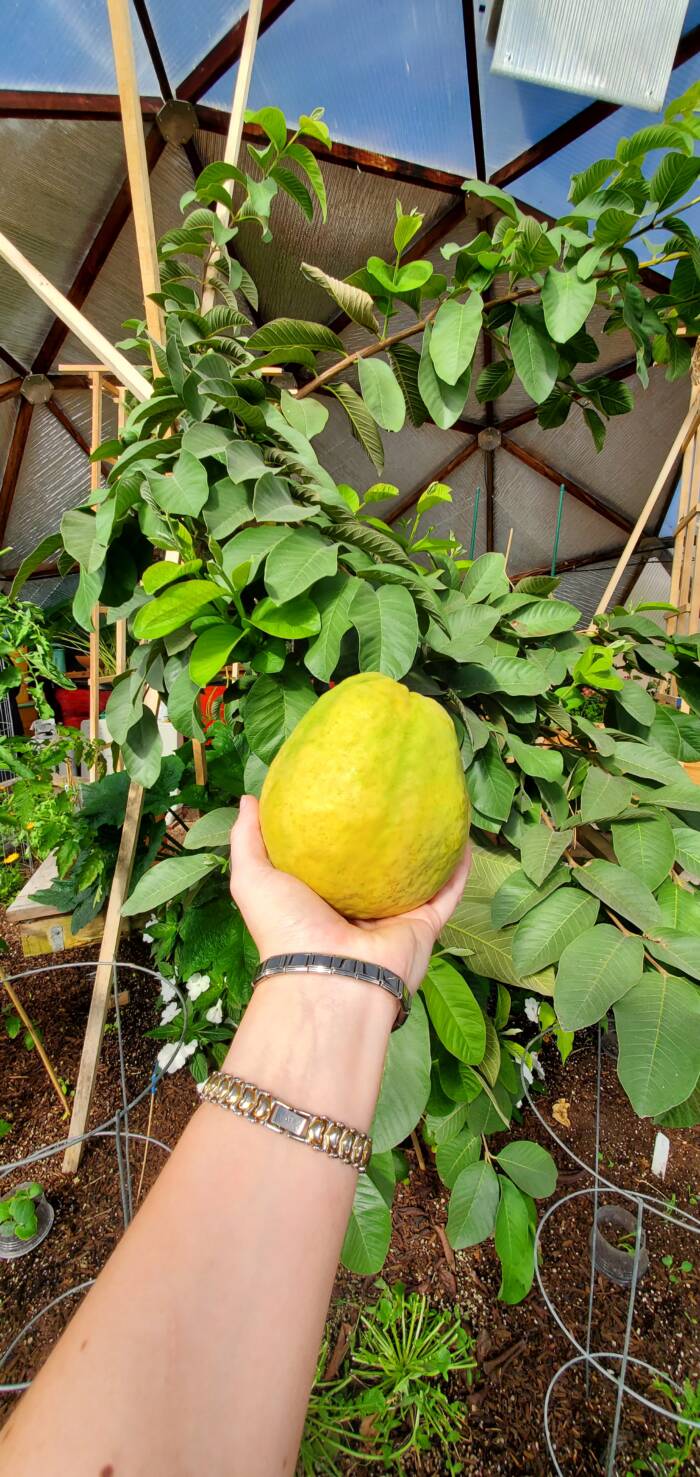
Harvest guava is by skin color, firmness and aroma! The most common guava variety has a green skin, which turns yellow when ripe. Harvest guava when the fruit is still firm, it will ripen after being picked. It should feel slightly soft under light pressure; don’t squeeze too hard or you’ll have fresh guava jam!
Guava flowers are very fragrant and sweet due to the oils in the flowers. The aroma of ripe guava is sweet, fruity, a bit musky and distinctive. The aroma will make you feel as if you are in the tropics. Interestingly, overly ripe guava smells like stinky socks…and nobody wants to smell that!
Pruning Guava
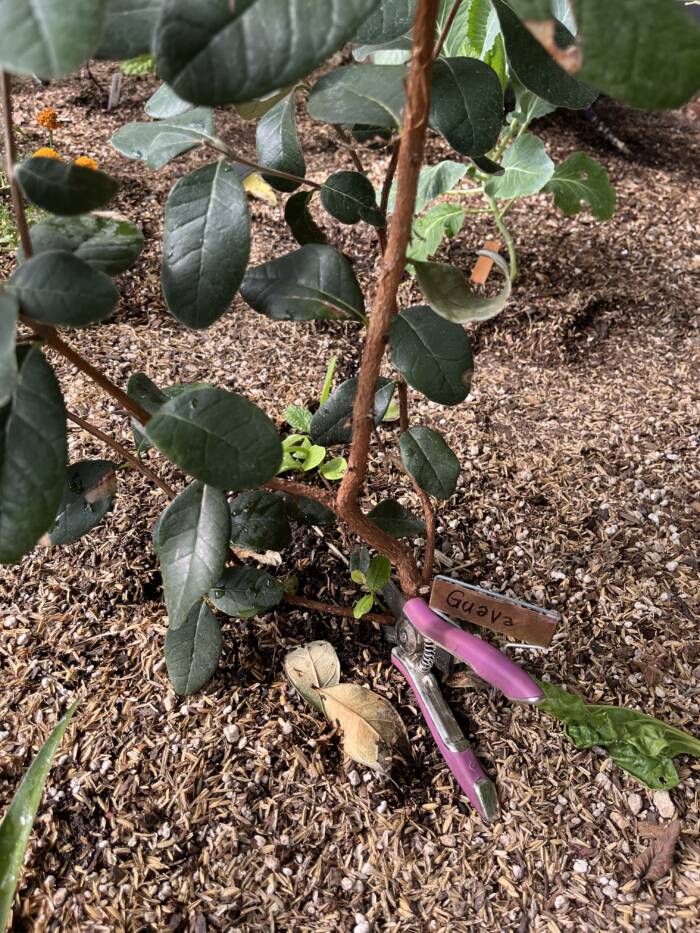
If you want to grow your guava as a shrub, leave the lower branches in place. To grow guava into tree form, rather than a shrub, trim the low growing sucker shoot. Trim them as close to the base of the tree as possible. Your guava needs as much sun as possible so lightly pruning the canopy will increase both light and airflow. Fruit forms off new shoots from mature wood, so do not remove all the new growth when pruning.
Prune your guava tree in late winter every other year to maintain height and leave some of the mature wood in place. Prune over any buds and leave room for future growth. A guava tree with a single trunk and a minimum of three to four lateral branches will have a beautifully shaped canopy.
The other important factor regarding pruning is to remove any branches that have disease or have been damaged. It is also important to sterilize any tools used to prevent disease from spreading between plants.
History of Guava and Guava Trivia
There is archaeological evidence of guava in Peru as early as 800 BCE. Spanish and Portuguese traders took guava to Mexico, the Caribbean and then around the world. The earliest recorded history of guava in North America is Florida in 1765. These days the main producers of guava are Brazil and Hawai’i.
- Boil young guava leaves into a tea and use the tea to clean wounds.
- The meat smoking community prefers using guava wood as it complements each flavor.
- The center of a guava has between 100-300 edible seeds.
- The lifespan of a guava tree is about 40 years.
Health Benefits of Growing Guava
Loaded with vitamin C, guava has four times the amount found in an orange! That’s a powerful fruit! Plus it tastes delicious so that’s a winning dome plant to have. Try our homemade guava jam recipe! Guava leaves are very aromatic and medicinal as well.
We hope you enjoyed learning about growing guava…happy gardening!
Join the Inner Circle
An exclusive place for year-round gardeners. Join us to receive our monthly newsletter, “The Happy Grower”. In our newsletter we provide community stories, event updates, expert gardening tips, and exclusive offers.
